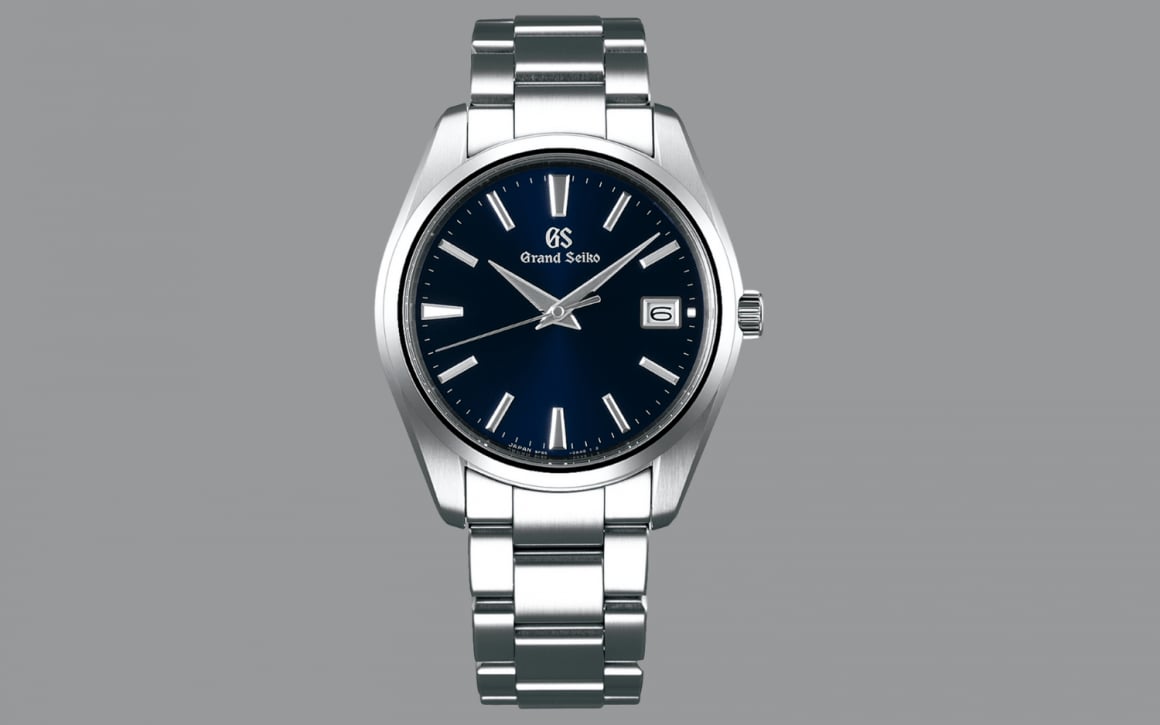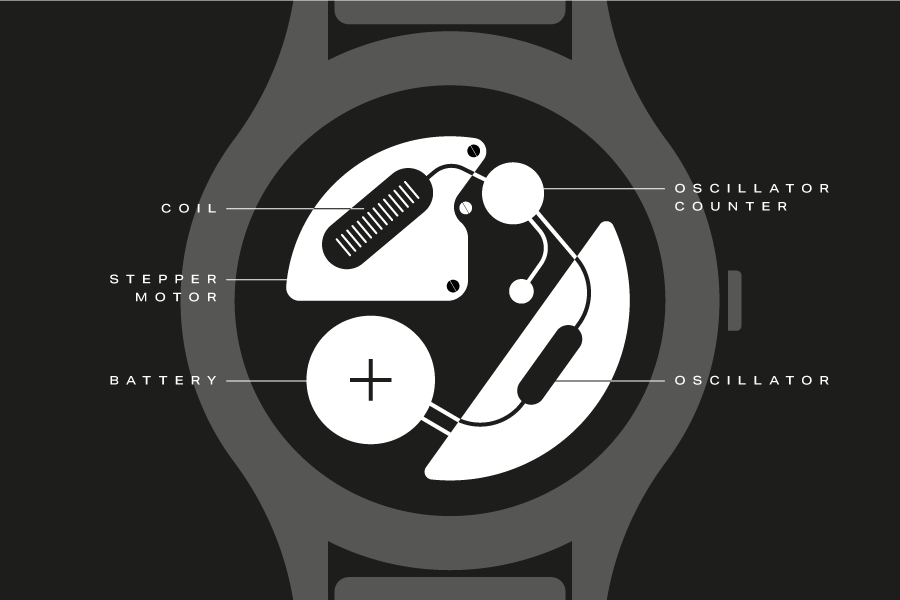A Guide To Quartz Watch Movements
By Sarah Jayne Potter | 5 minute read

A watch’s movement, also known as its calibre, is often thought of as the engine to a timepiece. A sophisticated network of intricate parts that power the hands on the dial and all complications. In this guide we’ll take a look at the quartz movement’s compelling history and explore the fundamentals of how one works; along with the benefits it can provide and maintenance required.
A brief history of quartz watch movements
Owing to a prestigious history and heritage of exquisite craftsmanship, Switzerland sets a tremendous standard for all other watchmakers. During the 16th century, the Swiss watch industry steadily became the home of fine watchmaking and by the end of the 18th century, Geneva was exporting over 60,000 watches per year. One of the innovations of this time was the perpetual watch – the blueprint for today’s self-winding timepiece.
However, it was not to be smooth sailing for Switzerland forever. Throughout the 1970s and 80s, Japanese watch company Seiko successfully derailed the industry with what’s commonly referred to as the Quartz Crisis. The Japanese brand’s introduction of the world’s first commercially available quartz-clock wristwatch – the Astron – in 1969 caused incredible upheaval in the traditional watch industry, which was late to adapt to these changes in technology. The Astron showcased that instead of an intricate network of mechanics, a timepiece could be simply powered with a small crystal, battery, and motors.
The lure of this new, cutting-edge technology that could more accurately tell the time and was significantly less costly, became irresistible. Watchmakers in the USA and Far East began to thrive at the expense of the traditional brands. It’s estimated that during this period around 900 Swiss watch brands went bankrupt, and two thirds of the workforce lost their jobs.
After several decades of industry upheaval, and with watchmakers all over the world taking on the challenge to create the slimmest, most high-quality quartz timepieces, this bleak period in Switzerland’s watchmaking history soon subsided. Quartz technology was embraced by the traditionalists and has since gone on to thrive with advances in innovation, such as solar- and motion-powered watches.
For the traditionalists, quartz watches still can’t hold a candle to the masterful engineering of a mechanical movement watch. However, a quartz is well worth the consideration, owing to such precise accuracy alongside considered detail and elegant aesthetics.
In fact, the Quartz Crisis is now nothing more than a past chapter in the long and prestigious history of Swiss watchmaking. Its acceptance of quartz as a viable power source has led to the mark of ‘Swiss quartz movement’ being a signifier of excellence in both heritage and craftsmanship.
What is a quartz watch movement?
A quartz watch movement uses a battery as its primary power source. It’s the force behind the dial that drives the hands and powers all complications. The battery sends an electrical current through a small quartz crystal, which electrifies it and creates vibrations. Those vibrations keep the movement oscillating and power the motor that moves the watch hands. Unlike the smooth sweeping motion of a mechanical movement, the second hand of a quartz watch moves in distinct individual ticks.
It’s highly likely that a quartz movement is behind the functionality of a standard, everyday timepiece owing to its meticulous reliability. In fact, around 90% of the world’s watches use a battery as their power source. The maintenance is minimal and the price tag is much more cost effective. Couple this with the fact that the timekeeping of a quartz watch is the most accurate available, and it becomes clear why the emergence of quartz caused an upheaval within the world of horology.

How does a quartz watch movement work?
- Battery
- Quartz crystal
- Stepping motor
- Dial train
- Watch hands
The battery sends electricity through an integrated circuit to the quartz crystal, which is shaped like a tuning fork.
The electric charge makes the crystal vibrate at a rate of 32,768 times per second. These oscillations are detected by the circuit and turned into electric pulses sent to the stepping motor.
The electrical pulses drive the stepping motor which converts the electrical energy into mechanical power that turns the gears.
The dial train moves the hands of the watch, and each pulse is sent here at a rate of one per second.
This pulse drives the watch hands, giving them their distinct individual ticking motion.
To understand why a quartz movement provides superior accuracy over any other type of movement, it’s useful to look at the mechanical watch first. Within a mechanical movement, energy supplied by winding the watch must be sent through its many various parts, all of which use up the energy and therefore incremental power is lost.
With a quartz movement however, there are less moving parts to consume the energy, so any power needed to keep the crystal oscillating is retained.
Benefits of a quartz watch movement
Superior Accuracy
A quartz crystal always oscillates at the same frequency. This natural rhythm is much more reliable than the physical movements of a mechanical watch, and results in exceptional accuracy.
More Affordable
Quartz watches are battery powered and therefore require less parts and haute watchmaking craftsmanship than their intricate mechanical counterparts. Together this results in a more affordable product.
Minimal Maintenance
Other than the occasional battery replacement every one to two years, the maintenance needed for a quartz watch is very low. There’s no need to worry about winding or any other type of interference to ensure it keeps ticking.
More durable
There are far fewer moving parts within a quartz watch compared to a mechanical one, which mitigates the number of things that could require repair. A quartz watch can be extremely robust and run for a lifetime.
Maintenance of a quartz watch
Change the battery promptly
When the time comes to change the watch’s battery, be sure to do so as soon as possible. Dead batteries will leak and a major service will be required to clean the timepiece up. Fortunately a battery change is a simple affair that all watchmakers can undertake.
Get your timepiece regularly serviced
Just like all luxury timepieces, a quartz watch will need a service. However, because it has so few moving parts, there’s less to keep in working order and a professional service is only needed once every 10 years. Although it’s always a good idea to double check this against your particular watch brand’s advice.
Clean it regularly
Getting into the routine of giving your timepiece a light daily dust, and a more thorough soap-and-water clean every three to four months, will ensure it stays immaculate and gleaming.
Consider proper storage
A purpose-made watch box or the original display box are two of the best ways to keep your timepiece safe, and free from any bumps or scratches, when it’s not being worn.


